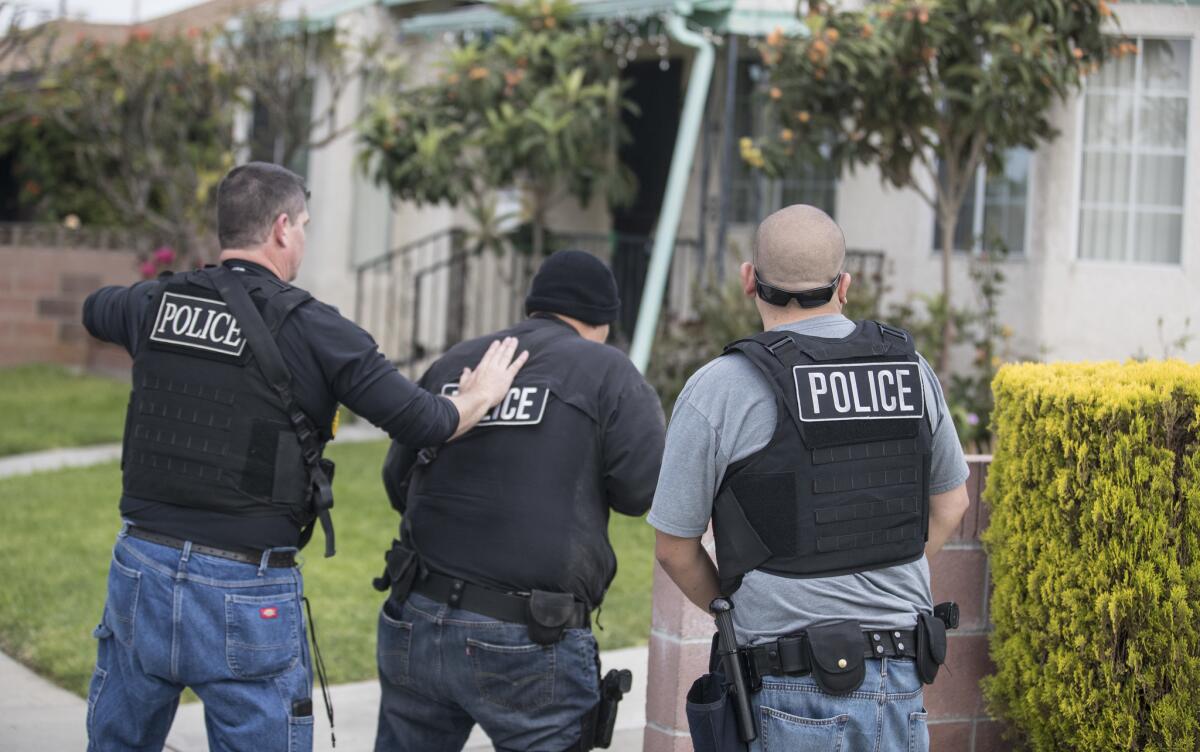ICE arrests hundreds of immigrants in ‘sanctuary cities’ around the nation, California

- Share via
Immigration officials on Thursday announced hundreds of arrests in an operation targeting communities where police and elected officials have refused to fully cooperate on enforcing federal immigration laws.
ICE said it arrested 167 people in and around Los Angeles, a region in which several cities and counties have been tagged by justice officials as being so-called sanctuaries — a loosely defined term used to describe local governments that restrict police from assisting immigration authorities in identifying and detaining people suspected of being in the country illegally.
Arrests were also made in San Francisco and San Jose. Overall, ICE said it arrested nearly 500 people across the country over the last few days.
The surge of arrests was similar in size to several past operations ICE has carried out in recent years. But the focus on places deemed by justice officials to be soft on illegal immigration served to ratchet up an already tense standoff.
With President Trump pushing for a sweeping crackdown on the estimated 12 million people living in the country illegally, he and U.S. Atty. Gen. Jeff Sessions have insisted that local law enforcement agencies give immigration agents unfettered access to jails and delay releasing immigrants from custody so that agents can nab them.
Officials in Los Angeles, San Francisco and other liberal-leaning communities have rebuffed the demands, passing local laws or implementing policies that restrict what police can and cannot do for ICE agents. Resistance has come from more conservative corners as well, where authorities have been unwilling to hold on to inmates for ICE out of concern that doing so is illegal.
In response, Sessions has angrily gone after cities he deems uncooperative, lashing out at them in speeches and threatening to withhold funds — a move the courts have so far blocked as unconstitutional.
The spate of arrests was the latest volley in Sessions’ campaign.
“Sanctuary jurisdictions that do not honor detainers or allow us access to jails and prisons are shielding criminal aliens from immigration enforcement and creating a magnet for illegal immigration,” said ICE Acting Director Tom Homan in a statement announcing the arrests. “As a result, ICE is forced to dedicate more resources to conduct at-large arrests in these communities.”
As in past operations, ICE officials said they primarily went after people with criminal pasts and said participants in the Deferred Action for Childhood Arrivals program, DACA, were not targeted.
All told, more than 300 of those arrested had criminal convictions, according to figures released by ICE. Nearly 90 of those people had been convicted of drunk driving, the most common offense.
In a press release, ICE highlighted the most serious criminals caught. It described the arrest of a Colonia Chiques gang member in Los Angeles as part of the raid, saying he “rammed multiple law enforcement vehicles in an effort to evade arrest” and was found with a loaded handgun.
Talia Inlender, a senior staff attorney at Public Counsel, which advocates for immigrants, criticized the focus on sanctuary cities.
“It’s clearly a political move that is not actually geared toward public safety,” she said.
The “sanctuary city” term dates back to the 1980s, when Berkeley and a few other municipalities declared themselves as such to accept migrants from Central America. At the time, U.S. immigration policies allowed some Central Americans, but not others, to enter the country.
There is no clear definition of a sanctuary city, but in general, cities that adopt the designation seek to offer political support or practical protections to people who are in the country illegally.
For some cities, the sanctuary movement consists simply of encouraging people without legal status to get more involved in government. Other places, such as San Francisco, adopt far-reaching policies, such as taking steps to cut ties with federal immigration officials and refusing to fully cooperate with them.
Earlier this month, officials said they want to formally declare Los Angeles a “city of sanctuary,” in response to Trump’s moves to end DACA.
For more news on federal agencies and courts in Southern California, follow me on Twitter: @joelrubin
ALSO
Immigrants held in remote ICE facilities struggle to find legal aid before they’re deported
Trump plans to slash refugee admissions by more than half
Continuing a fierce assault on ‘sanctuary’ policies, Sessions attacks California bill
UPDATES:
6 p.m.: Updated with background on sanctuary cities in California.
3:40 p.m.: This article was updated with additional details from the arrests along with a statement from the acting director of ICE, a comment from a public counsel attorney and background about the Trump administration’s position on sanctuary cities.
This article was originally published at 2 p.m.
More to Read
Sign up for Essential California
The most important California stories and recommendations in your inbox every morning.
You may occasionally receive promotional content from the Los Angeles Times.











